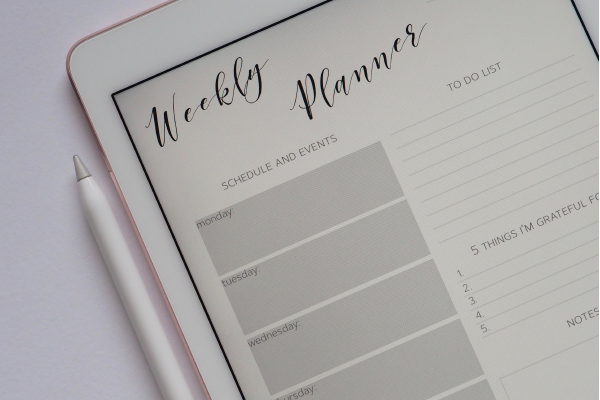Improve your ability to manage competing obligations by following a few straightforward guidelines.
We thank Jamie Jackson Spannhake, Esq. for this helpful guest post.
ICYMI — Part 1 of Transforming Your Relationship with Time: Shifting Language + Perspective.
. . .
As lawyers, we have so many responsibilities to manage simultaneously. I call these “competing obligations.” They include the seemingly endless tasks in the practice of law to assist clients and colleagues, the deadlines we must meet, our family obligations, our desires for personal time and connection, and time to rest and recharge, which is particularly important for our health and wellness.
One of the best ways to keep all these competing obligations in order and successfully handled is to organize your time for productivity so that you can utilize the time in each day as efficiently as possible.
The first step to organizing your time is planning. When I am overwhelmed with work and life, I want to jump in as quickly as possible and tackle things. Who has time to plan? Resist that temptation. Take a breath, and take the time to plan. Would you build a house without first drafting a plan? Of course not. Take the same approach to your day and your life. You actually save time when you make a good and thoughtful plan. As A.A. Milne said, “Organizing is what you do before you do something so that when you do it, it is not all mixed up.”
Start with a thoughtful plan for how you will use your time by following these 3 guidelines.
- Plan everything and put it on the calendar.
Plan on a yearly, weekly, daily, and by project basis. Keep one calendar with everything on it — work deadlines and appointments, family obligations, and personal items (like exercise) — and sync it to all your devices. My friend Vanessa Price, who is a solo attorney in Southaven, Mississippi, works about 50 hours a week. She is married to a lawyer and has two school-age children. For her, the only way she can manage work, life, and family is by sitting down every Sunday with her husband and kids to plan the week. “We lay out all items on the calendar: kids’ activities, soccer, baseball games, driving the kids, gym classes, work stuff, everything,” she says.
Like my friend, I put everything in my Google calendar, which I can access on all my devices (work laptop and phone, personal laptop and phone, and any other device with internet). I follow the calendar. This is especially important for me when it comes to exercising. I can always find a reason not to work out, but if I have my workout scheduled in the calendar, including the distance I plan to run or the time that my tennis clinic starts, then I’m much less likely to blow it off.
Your calendar is your aspirational plan — the way you want the day to go if you could control everything. But not everything will go as planned, so remain flexible and readjust when things change. When things don’t go as planned, I recalibrate and review at the end of each day. Of course, no matter how carefully we plan our lives, we don’t have control over everything.
- “Chunk” your work into manageable timeframes and take breaks.
It’s easier to keep your time organized and your efforts focused in smaller chunks of time, so schedule your work in increments — 45 to 90 minutes is typically ideal, but pay attention to your own style and work. Plan to take a break after each increment, or switch to something else. If you must keep working, switch to a separate project or to a new task within the same project, for example, switching from writing to reviewing documents or responding to client email. If you can, schedule in short breaks — go for a walk, do five minutes of stretching, or engage in a meditation mini-session.
Also schedule in a longer break each day, if possible, where you can get some exercise for rejuvenation and return to work with increased focus.
- Use your time creatively and multitask wisely.
Schedule snippets of “extra” time. Early on a weekend morning before the family wakes up, or in the evening after everyone else goes to bed, can provide more time for work or personal tasks. If you have more control over your schedule, you can work hours that fit your life — for example, not working after the kids get home from school until after they go to bed, then heading into your home office, for late evening hours. (But don’t skimp on your sleep; that’s a no-no when it comes to good health!)
Also get creative with multitasking. Despite research on the negative impact of multitasking on productivity, you can multitask wisely by combining an intellectual task with a mindless task. Some examples? Dictate a blog post or presentation or email response on your smartphone while walking for some exercise, then convert it to text and email it to yourself. Or dictate a to-do list and client updates into a small digital recorder while driving between meetings or events.
Now On Demand! My presentation of Webinars for Busy Lawyers explores tools and actionable techniques to manage competing responsibilities.
Transforming Your Relationship with Time as a Lawyer
. . .
 Jamie Jackson Spannhake is a lawyer, writer, speaker, and coach. She practices law as a partner at Berlandi Nussbaum & Reitzas LLP, serving clients in Connecticut and New York. She is author of the book The Lawyer, the Lion & the Laundry: Three Hours to Finding Your Calm in the Chaos (Oct. 2019, Attorney at Work), which was named by Bigle Legal as one of the Best Books for Lawyers to read in 2019, specifically in the category of Personal Growth and Happiness. Jamie received her certification as a health coach from the Institute for Integrative Nutrition in New York City. She regularly writes and speaks on issues important to lawyers, including “mind management,” stress management, work-life integration, and time management.
Jamie Jackson Spannhake is a lawyer, writer, speaker, and coach. She practices law as a partner at Berlandi Nussbaum & Reitzas LLP, serving clients in Connecticut and New York. She is author of the book The Lawyer, the Lion & the Laundry: Three Hours to Finding Your Calm in the Chaos (Oct. 2019, Attorney at Work), which was named by Bigle Legal as one of the Best Books for Lawyers to read in 2019, specifically in the category of Personal Growth and Happiness. Jamie received her certification as a health coach from the Institute for Integrative Nutrition in New York City. She regularly writes and speaks on issues important to lawyers, including “mind management,” stress management, work-life integration, and time management.
. . .
More Resources from Mass LOMAP
Explore our posts on Time Management & Productivity here.





